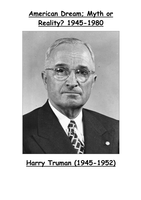American Dream; Myth or
Reality? 1945-1980
Harry Truman (1945-1952)
, A: Post-war America
Legacies of the Second World War
Notes or
Historiography
Europe endured significant casualties, mass destruction, huge social disruption
and serious economic hardship.
America conversely, remained relatively untouched (no foreign soldier set foot
on American soil)
By the start of 1945, the USA was clearly in the strongest position of any
country.
- 7% of the global population, but 42% of the world’s income, 62% of its
discovered oil, 50% of its manufacturing output, 80% of its cars and 33
million households owned a radio.
The economy had recovered partly due to war spending and the militarisation
of the economy, and partly due to the New Deal and post-Recession recovery
put in place by Truman’s predecessor Franklin Roosevelt.
Death of Roosevelt
FDR died on 12th April 1945 following a stroke with his approval rate at 70% at
the time of his death.
His successor was his Vice-President Harry S Truman, a former haberdasher
who had carved out his career as a hardworking and honest politician.
Roosevelt had left a country still involved in World War 2, which whilst GDP
growth was at an average of 7.5% per year, unemployment was still high
at an estimated 8 million.
In addition, the demography of the US was divided.
- North vs South: The North East (NY, PA, VA) was seen as the political and
financial powerhouse of the USA. In addition, Midwest states like MI and
IL could boast about their manufacturing power. The South was more
traditional, characterised as gun-owning, church-going dog-lovers. Certain
areas of the South were wealthy due to oil, but it was more sparsely
populated.
- Ethnic Divisions: Over 130 million were white, Asian-Americans numbered
320,000, African-Americans were roughly 14 million. Blacks were
concentrated in the South due to the legacy of slavery and had slowly been
moving north (the ‘Great Migration’), but the majority could not afford to
and were subject to the Jim Crow Laws which upheld segregation.
- Social Divisions: For non-minorities, the Great Depression had levelled out
inequalities between rich and poor. However, African-Americans and Native-
Americans were at the bottom of the socio-economic ladder. A post-war
boom had hidden the extent of poverty until the 1960’s. Society was also
changing as women worked more, Trade Unions were being formed and
people were very wary of the threat of communism.





